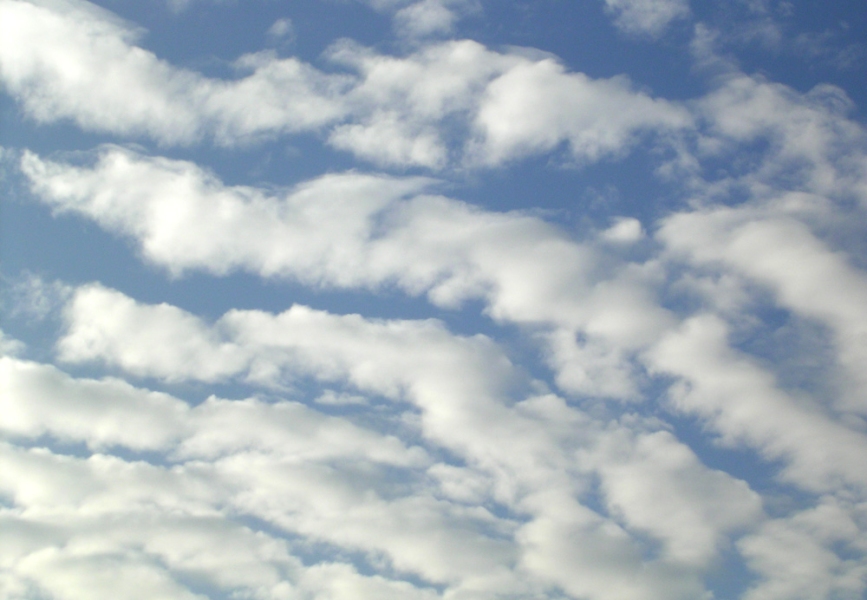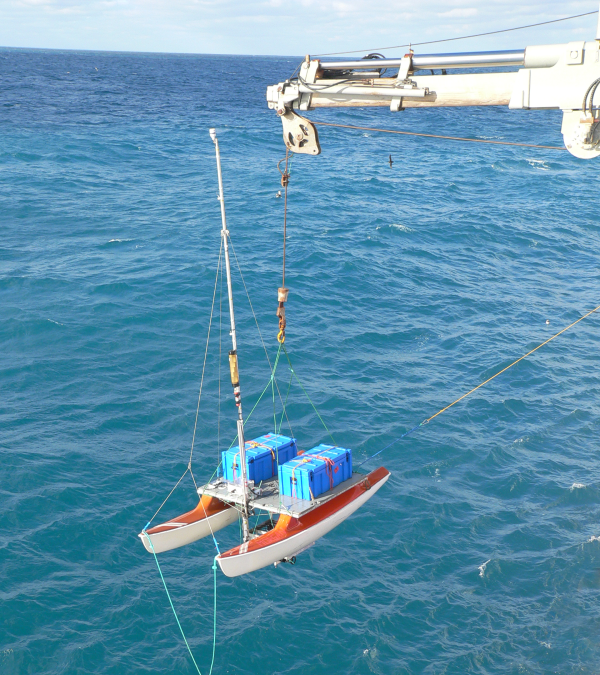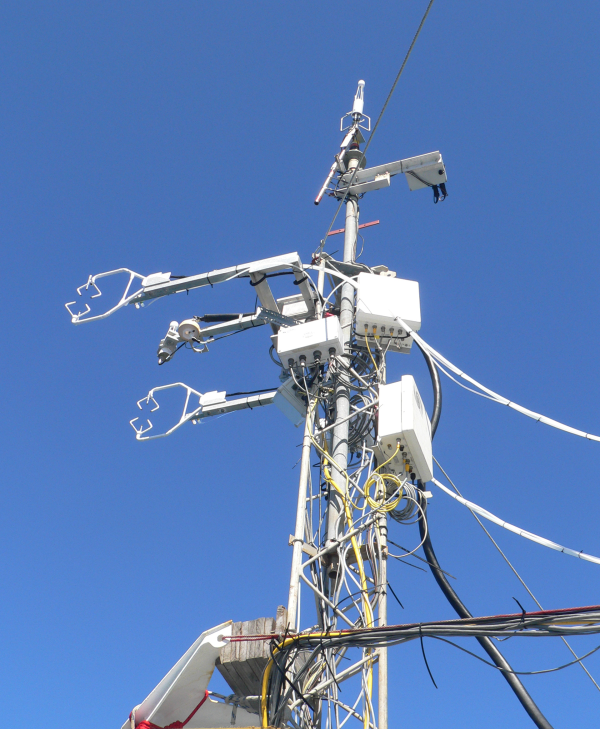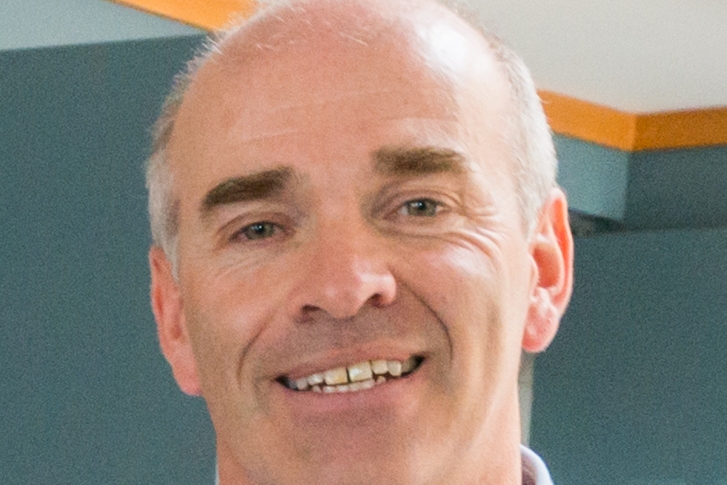How do marine micro-organisms influence the earth's atmosphere and climate? SOAP is a NZ SOLAS project that investigated the relationship between phytoplankton biomass and species distribution, and the flux of gases to the atmosphere which are related to cloud formation.
Overview
Stratocumulus clouds over the ocean reflect sunlight back to space, which has a large effect on the climate. The amount of reflection depends on such properties as the size of droplets that make up the cloud. Clouds form as a result of water vapour condensing around tiny aerosol particles - around 100nm in size – called cloud condensation nuclei (CCN). The source of these CCN can be primary aerosols, such as sea salt particles and organic material, which can be lofted into the air from the sea surface by bubble bursting associated with breaking waves.
In addition to the direct injection of particles from the sea surface, phytoplankton produce a range of gases that are released into the atmosphere and can influence aerosol production. These compounds include gases such as dimethylsulphide (DMS) which is oxidised to form sulfur aerosols, halocarbons and ammonia and a range of volatile organic hydrocarbons such as isoprene, ketones.
Read more about New Zealand ocean-atmosphere interactions (SOLAS)
Questions
Do phytoplankton in productive waters around New Zealand affect aerosol production and thus cloud properties? If so, which phytoplankton groups and mechanisms of aerosol formation are most important?
Approach
The frontal regions around New Zealand are highly productive, with the Sub-Tropical Front that runs eastwards along the Chatham Rise characterized by intensive phytoplankton blooms. To determine whether the regions influence the production, composition and properties of aerosols in the marine boundary layer, a pilot study (PreSOAP) was carried out in February 2011. This was followed by the SOAP (Surface Ocean Aerosol Production) voyage on the R.V. Tangaroa in February-March 2012.
Sampling took place primarily in three phytoplankton blooms with different characteristics:
- Bloom 1 was dominated by dinoflagellates with low CO2 and high DMS in surface waters, whereas
- Bloom 2 was dominated by coccolithophores (phytoplankton with carbonate shells), and Bloom 3 had mixed coccolithophore/dinoflagellate population. Blooms 2 and 3 both had moderate CO2 but lower DMS than Bloom 1.
Investigators looked at 3 key aspects:
- surface ocean biogeochemistry, including the surface microlayer, to examine the relationships between the distribution of dissolved gases (DMS and CO2) and aerosols, and phytoplankton biomass and species composition.
- surface physics and exchange of matter between ocean and atmosphere, by measuring DMS and CO2 flux to and from the atmosphere, and examining relationships between gas transfer velocity and physical drivers such as near-surface turbulence, sea-state and whitecap coverage.
- atmospheric precursor gases and aerosols, by measuring particle size and composition in the marine boundary layer.
Outcome/results
A range of gaseous organic compounds were present, with significant quantities of DMS being emitted at times.
Measurements from the surface water while the ship was in motion (underway measurements ) showed a strong relationship between atmospheric and surface water DMS, in different regions, with some evidence that in light wind conditions near-surface or microlayer enrichment of DMS could be responsible for increasing emissions above those that would be estimated from the DMS found in near surface waters. Underway measurements of the pigment chlorophyll-a - an indicator of phytoplankton abundance - will be compared with the surface distributions of DMS and CO2.
Ocean-atmosphere exchange rates of DMS and CO2 were determined using fast response sensors mounted on the ship's bow. Landwehr et al. (2014) obtained the valuable (but difficult) measurements of the CO2 transfer after demonstrating the appropriate method for eliminating air density fluctuations due to water vapour. For DMS, Bell et al. (2015) have found a linear dependence of DMS gas exchange coefficient with windspeed, with an indication that this relationship weakens in strong winds (> 12 m/s). Smith et al. (2014) made flux-gradient measurements from a free-floating catamaran and found good agreement with the eddy covariance estimates of Bell et al.
In addition to DMS, other potential particle precursors were examined. Lawson et al. (2015) made some of the first measurements of dicarbonyl compounds over remote temerate oceans; they found that known production/oxidation mechanisms can only account for about 10% of the observed glyoxal. Particle production in the marine boundary layer was continuously monitored, with additional experiments in a bubble chamber to examine particle formation processes. Both atmospheric measurements and lab experiments confirmed the presence of an organic fraction in the produced particles, particularly in ultrafine particles (< 15 µm) during intense sunlight, indicating the importance of photochemistry to production.
The field phase of the project is complete and detailed analyses by the international research team are progressing following a data workshop which took place in March 2013. Research papers are being published progressively in a joint special issue of Atmospheric Chemistry and Physics and Ocean Science journals.
International collaboration:
- University California Irvine (USA)
- Chapman University (USA)
- Plymouth Marine Laboratory (UK)
- NUIG (Ireland)
- IFM-Geomar (Germany)
- University Laval (Canada)
- SUNY (USA)
- Queensland University of Technology (Australia)
- University of Eastern Finland, CSIRO (Australia)
- University of Cambridge, U.K.
Outputs
Bell, T. G., De Bruyn, W., Marandino, C. A., Miller, S. D., Law, C. S., Smith, M. J., and Saltzman, E. S. 2015. Dimethylsulfide gas transfer coefficients from algal blooms in the Southern Ocean, Atmos. Chem. Phys., 15, 1783-1794, doi:10.5194/acp-15-1783-2015
Landwehr, S., Miller, S.D., Smith, M.J., Saltzman, E.S., Ward, B. 2014. Analysis of the PKT correction for direct CO2 flux measurements over the ocean. Atmos. Chem. Phys., 14, 3361-3372, doi:10.5194/acp-14-3361-2014.
Lawson, S.J., Selleck, P.W., Galbally, I.E., Keywood, M.D., Harvey, M.J., Lerot, C., Helmig, D., Ristovski, Z. 2015. Seasonal in situ observations of glyoxal and methylglyoxal over the temperate oceans of the Southern Hemisphere. Atmos. Chem. Phys., 15(1): 223-240. 10.5194/acp-15-223-2015
Smith, M., Walker, C., Law, C., Harvey, M., Bell, T., Lawson, S., Saltzman, E. 2014. Air-sea gradient fluxes of DMS during Surface Ocean Aerosol Production (SOAP) experiment. Earth Observation for Ocean-Atmosphere Interactions Science, Frascati, Italy
Law, C.S., Mike Harvey, Murray Smith and the SOAP Team. 2012. Surface Ocean Aerosol Production (SOAP) in the south-west Pacific Ocean. SOLAS Newsletter
Law, C.S. and the SOAP Team. Surface ocean aerosol production (SOAP) in the South-West Pacific. SOLAS Open Science Conference, Seattle, USA, May 7-10/5/2012.
Lawson, S., Keywood, M., Galbally, I., Harvey, M., Law, C., Selleck, P. Cheng, M. and Z. Ristovski. Characterising VOCs in the Marine Boundary Layer during the SOAP voyage, Chatham Rise 44oS. SOLAS Open Science Conference, Seattle, USA, May 7-10/5/2012
C. Walker, C. Law, M. Harvey, M. Smith, A. Marriner, J. McGregor, M. Lizotte and M. Levasseur. 2012. Air-sea interface production and near-surface concentrations of dimethylsulphide in the South-West Pacific. SOLAS Open Science Conference, Seattle, USA, May 7-10/5/2012.
Law. C.S., Harvey, M. and Smith M. SOAP (TAN1203) voyage report






